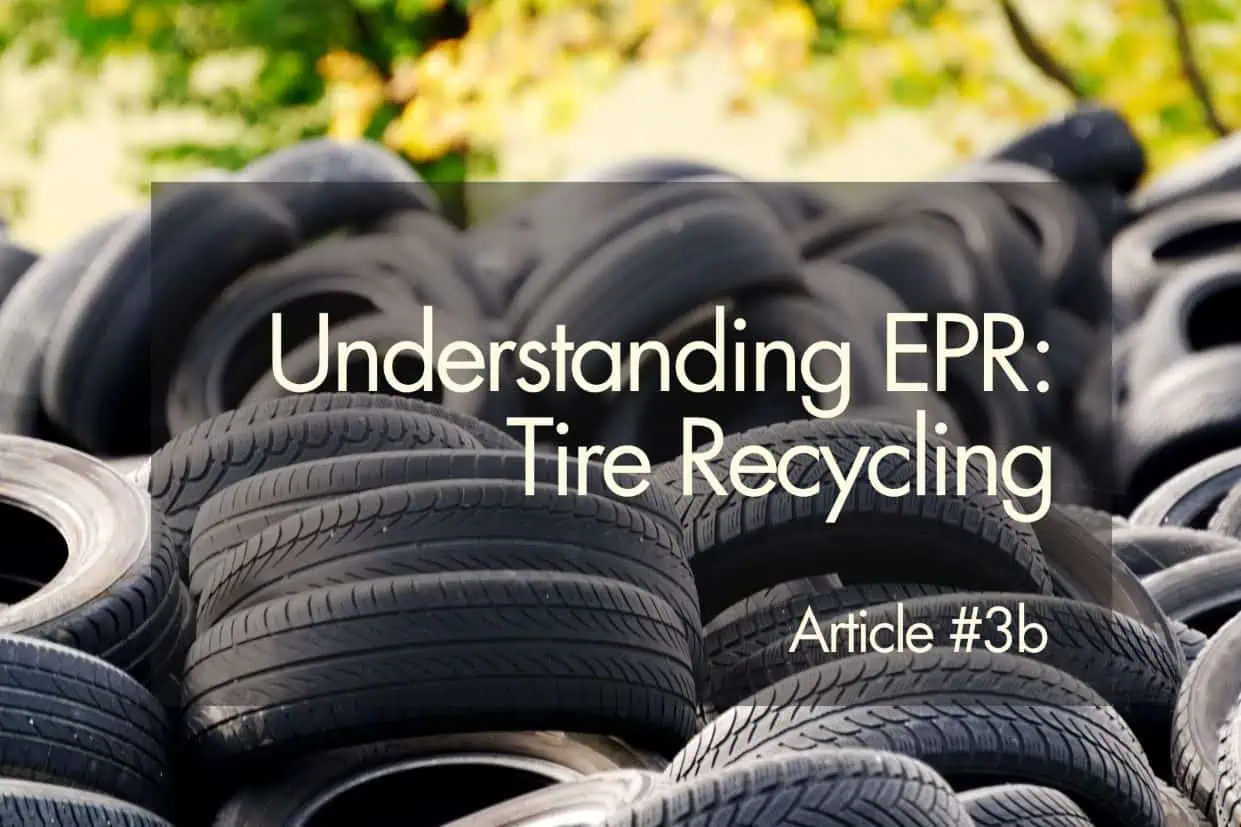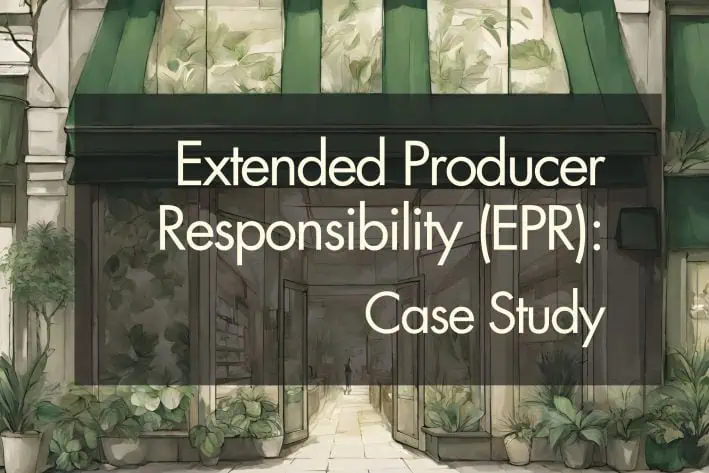Every year in Ontario, Canada, an alarming 12 million new tires are sold. To combat this, in 2019, the Ontario Provincial Government introduced the Tire Regulation as a part of the Resource Recovery and Circular Economy Act. This regulation introduced tires as the first material to be regulated under the Individual Producer Responsibility Program (IPR) (RPRA, n.d.).
In this article, our guest author Yvonne Burwell explores:
Overview:
Prior to 2019, tire (RPRA, n.d.) producers would pay a fee to the Ontario Tire Stewardship (OTS), under the Used Tires Program, for every tire they manufactured and subsequently sold in Ontario. The OTA would then arrange for the collection and recycling of said tires (RPRA, n.d.).
In contrast to OTS, IPR holds manufacturers directly responsible for the resources’ end-of-life management. This IPR model puts full responsibility on the producers to collect, transport, and recycle the material into a valuable resource, effectively forcing the producers into creating a more circular economy (Meldrum & eTracks, 2021). Producers must recycle the same weight in tires that they produce.
IPR works by turning all tire vendors, car dealers, and any other retailers who work with tires into “collectors”. Collectors must accept tires, regardless of if they sold them or not, from consumers who drop them off at their location, as long as the tires are of a similar shape and size to the tires they sell (Tire Recycling Ontario, 2024). The collectors must then enter into commercial agreements directly with the producers or Producer Responsibility Organizations (PRO), who will organize the transportation of the used tires for no cost to the collector (RPRA, n.d.).
Infrastructure:
A Producer Responsibility Organization or PRO is a third-party business, who, for a fee, will provide tire producers with all of the services they need to meet their IPR requirements. PROs ensure tire producers meet all the requirements set out by the Resource Productivity and Recovery Authority, the government agency in charge of IPR compliance and regulation (RPRA, n.d.).
Finance:
Before the IPR regulations were introduced, consumers were charged an “eco-fee” tax in addition to the cost of the tires. This tax was typically $3.30 per tire. This tax was discontinued in 2018, to transition to the IPR model. Now, tire producers are responsible for the full cost of transportation, handling, management, recycling, and public awareness education. This being said, many producers have kept an extra fee in place of the tax, to help offset the added costs associated with compliance with IPR regulations. The purpose of this extra fee, as well as who is imposing it, must be communicated clearly to the customer (Connell, 2018).
Current State as of May, 2024:
Although tire producers are expected to foster public awareness and education on IPR, a 2020 survey by eTracks revealed that 32% of Ontarians remained unaware of the mandate requiring tire producers to recycle all tires they sell within Ontario (Meldrum & eTracks, 2021). Public awareness is not the only category where tire producers are falling short on their compliance with IPR. As a result, in 2023, the RPRA announced they would begin cracking down on PROs. In particular, the RPRA stated PROs needed to fix their dysfunctional collection sites. The RPRA performed a study that found 35% of collection sites did not collect used tires. The other 65% of collectors did accept tires but would charge for collection or would not accept tires if they were still on rims, both of which were not allowed under the IPR regulations.
In April of 2023, the RPRA required external audits of all 5 Ontario PROs, requiring them to prove compliance. If they fail, their producer client can be charged up to $200,000 plus any financial gains earned from breaking the law (Atkins, 2023).
That said, in 2022, 143,400 tonnes of tires were recovered by producers in Ontario. This increased the resource recovery rate from 86.63% in 2021 to 87.14% in 2022, surpassing the target of 85% for 2022 (RPRA, 2023).
Results of Recycling:
Recycled tires can be used in a variety of ways across many sectors. A popular use for recycled tires is outdoor rubber flooring, such as athletic fields, tracks, playgrounds, and patios (Ontario, 2009). End-of-life tires can also be transformed into many household materials such as carpet underlay and roofing shingles (EcoGreen, 2014). For example, Evolve Recycling Inc. turns tires into “crumb rubber”, which they then manufacture into “rubber landscaping pavers”, “multi-purpose mats”, “bases for safety cones”, and many other moulded rubber products (Evolve Recycling Inc, n.d.).
To learn more about other EPR systems, please click this link to return to the main article.

Yvonne Burwell
Yvonne is a Product Development professional based in Toronto, Canada, with a background in Business Administration and Sustainable Fashion Management. She brings her creative flair and passion for sustainability to Global Measure Inc., where she works on social media and research.
Curious to explore EPR further or interested in potential collaborations? Dive into our comprehensive Case Study for a deeper understanding.
References:
Atkins, E. (2023, April 13). Ontario’s RPRA warns tire industry to comply. Retrieved from Waste & Recycling: https://wasterecyclingmag.ca/extended-producer-responsibility-epr/ontarios-rpra-warns-tire-industry-to-comply/1003288552/
Connell, M. (2018, Nov 22). Government “Eco Fees” on New Tires Eliminated. Retrieved from SISKINDS The Law Firm : https://www.siskinds.com/government-eco-fees-new-tires-eliminated/
Eco Green. (2014). 7 Industries That Will Benefit the Most from Tire Recycling. Retrieved from Eco Green: https://ecogreenequipment.com/7-industries-that-will-benefit-the-most-from-tire-recycling/
Evolve Recycling Inc. (n.d.). ABOUT – EVOLVE RECYCLING INC. Retrieved from Evolve Recycling Inc. https://evolverecycling.ca/about/
Meldrum, S., & eTracks, T. M. (2021, July 13). Ontario end-of-life tire program is demonstrating IPR success on the road to a circular economy. Retrieved from Recycling Product News: https://www.recyclingproductnews.com/article/36876/ontario-end-of-life-tire-program-is-demonstrating-ipr-success-on-the-road-to-a-circular-economy
Ontario. (2009, April 09). Recycling Ontario’s Used Tires. Retrieved from Ontario Newsroom: https://news.ontario.ca/en/release/5457/recycling-ontarios-used-tires
RPRA. (2023, December 7). 2022 Electronics, Tires and Blue Box resource recovery data now posted. Retrieved from Resource Productivity & Recovery Authority : https://rpra.ca/2023/12/2022-electronics-tires-and-blue-box-resource-recovery-data-now-posted/
RPRA. (n.d.). About Us. Retrieved from Resource Productivity & Resource Authority : https://rpra.ca/about-us/who-we-are/
RPRA. (n.d.). Frequently Asked Questions. Retrieved from Resource Productivity & Recovery Authority: https://rpra.ca/faq/?faq_program=79&faq_topic=91#faq_results_container
RPRA. (n.d.). Tires. Retrieved from Resource Productivity & Recovery Authority: https://rpra.ca/programs/tires/
RPRA. (n.d.). Used Tires Program Wind Up. Retrieved from Resource Productivity & Recovery Authority: https://rpra.ca/programs/tires/used-tires-program-wind-up/
Tire Recycling Ontario . (2024). Tire Recycling Ontario . Retrieved from Tire Recycling Ontario : https://tirerecyclingontario.com/





